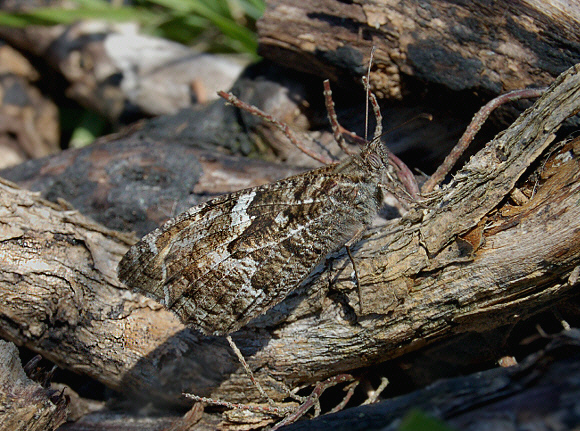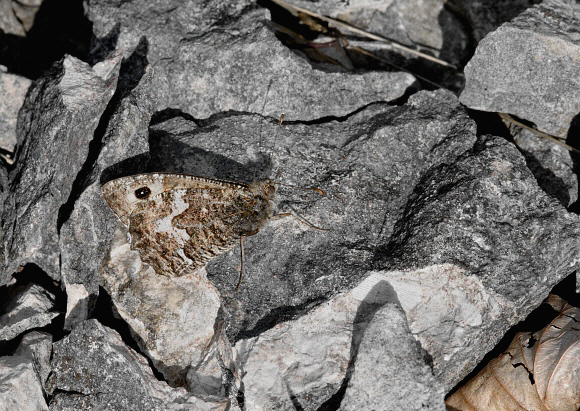 Grayling Hipparchia semele, female, Arnside Knott, Cumbria – Adrian Hoskins
Grayling Hipparchia semele, female, Arnside Knott, Cumbria – Adrian Hoskins
Introduction
There are 27 Hipparchia species, distributed variously across Europe, Asia and North Africa.
The uppersides of all species are dark earthy brown with prominent ocelli on the forewings in spaces 2 and 5, set within broad orange or brownish-white bands. When freshly emerged they often have a metallic greenish sheen along the costa. The underside hindwings are cryptically patterned with dark zig-zag lines and striations, and in most species there is a white band corresponding to that on the upperside.
The Grayling is distributed across much of Europe, but is absent from Greece, northern Scandinavia and most of the Mediterranean islands. On Corsica it is replaced by the endemic neomiris, and on Crete by cretica. The very similar aristaeus occurs on Sardinia, Algeria, Morocco, Turkey, Tunisia, Sicily and Greece. Another species with which the Grayling can easily be confused is pellucida, but that is restricted to Turkey, Cyprus and parts of the Middle East.
 Grayling Hipparchia semele, male, Wareham Heath, Dorset – Adrian Hoskins
Grayling Hipparchia semele, male, Wareham Heath, Dorset – Adrian Hoskins
Habitats
The Grayling breeds at sun-baked, well drained sites where sheep’s fescue or marram grass grow sparsely on otherwise bare ground. In Britain it is primarily a coastal species found on sand dunes, shingle banks, cliffs, undercliffs, limestone pavement and chalk / limestone scree.
It also occurs up to about 20m ( 35km ) inland on dry heathland and moorland habitats in Cornwall, Devon, Dorset, Hampshire, Sussex and East Anglia, but has contracted it’s range during the last 50 years, become increasingly coastal. On heathlands it occurs mainly along fire breaks or in areas where controlled burning has created a dry grassy habitat with extensive areas of bare ground.
Most Grayling colonies are small, probably numbering less than 20 adults on the peak day of the flight season. There are a few large expanses of dry heathland where the butterfly can be found in hundreds or even thousands, but these are generally comprised of a large number of much smaller colonies which exist in a mosaic of dry / humid heaths, bogs and forested areas.
Lifecycle
Graylings emerge in July and lay their eggs singly on the stems and blades of fine grasses, typically selecting little tufts growing in sunlit depressions, in areas where the grasses grow sparsely amidst extensive areas of bare ground. Sheep’s fescue grass Festuca ovina is used on chalk or limestone habitats, bristle bent Agrostis setacea on heathland, and marram Ammophila araenaria on sand dunes. A much wider range of grass species is used in continental Europe.
The larva hatches after about 2-3 weeks. Like most Satyrine larvae it feeds nocturnally, and during daytime it hides away at the base of a grass clump. It hibernates from September to March when it resumes feeding, and becomes fully grown in late May or early June.The mature larva is a dull yellowish brown colour, with whitish-edged dark stripes along the back and sides. When ready to pupate it wanders a short distance and burrows just beneath the surface of the soil, where the change to the pupa takes place.
The pupa is reddish brown, shiny and smooth, with a hooked abdomen. It is formed among soil just below the surface of the ground, in a silk-lined cell. The pupal stage lasts for about 3 – 4 weeks.
 Hipparchia semele, perfectly disguised at rest on dead wood, Hampshire – Adrian Hoskins
Hipparchia semele, perfectly disguised at rest on dead wood, Hampshire – Adrian Hoskins
Adult behaviour
The marbled underside wings are a superb example of disruptive patterning, enabling the butterfly to blend perfectly into a variety of different environments. The butterfly spends long periods at rest, and is equally well concealed when resting on tree trunks, bare earth, shingle or rocks.
When disturbed, Graylings take flight instantly, twisting and looping rapidly, just above the ground, before re-settling nearby on bare earth or on a tree trunk or fallen branch. When settling at ground level they usually rest on a pale object such as a stone or a piece of dry wood.
Upon landing they snap their wings shut, but raise the forewings so that the eyespot near the apex is visible. This way, any bird which spots where a butterfly has landed, and attacks, is likely to aim at the eyespot rather than at the body. Once the Grayling feels safe, it lowers the forewing to hide the eyespot behind the hindwing.
Overnight or in poor weather the butterflies roost in trees or bushes. At Arnside Knott in Cumbria I have often watched Graylings flying down from treetops early in the morning, settling on limestone scree below. Upon settling they tilt over to present the maximum area of wing surface to the sun, which quickly raises their body temperature. This enables them to maintain high energy levels, and remain alert at all times, instantly ready to fly up and intercept potential mates. In hot conditions they tilt their wings in the opposite direction to avoid over-heating, by minimising the amount of sunlight hitting the wings. This form of thermoregulation is commonly known as tilt-basking.

Grayling Hipparchia semele, male, Silchester Common, Hampshire – Adrian Hoskins
Favourite nectar sources include bell heather and cross leaved heath. Graylings often settle head-downwards when nectaring at these plants, enabling them to reach into the drooping flowers with their proboscises. When feeding at other flowers e.g. marjoram, hemp agrimony, valerian, thistles or bramble they settle conventionally. As well as feeding at flowers, both sexes commonly imbibe sap from pine trunks at heathland sites, and from ash trunks at calcareous habitats.

Grayling Hipparchia semele male, Arnside Knott, Cumbria – Adrian Hoskins

Grayling Hipparchia semele Arnside Knott, Cumbria – Adrian Hoskins

Hipparchia semele, male, Arnside Knott, Cumbria – Adrian Hoskins
Graylings do not normally open their wings when settled, but copulated females will do so briefly if approached by a second intruding male. At such times the wings are held half open or fully open for 3 or 4 seconds, displaying the richly coloured upperside and prominent ocelli.
Normally the butterflies rest at ground level, but at some sites they prefer to settle on tree trunks, and at sites in northern and western England they habitually settle on dry-stone walls. In July 2007 at Wareham Heath I found a male settled on a log. Every time I approached, it flew up, then circled around me and resettled on the same log. This behaviour is typical of territorial species and indeed there have been many occasions when I’ve observed males in combat. In July 2009 at Arnside e.g. I watched a long battle in which a pair of males spiralled up to a height of about 2 metres, chasing each other rapidly in tight circles until the intruding male was driven off.
Despite such territorial behaviour, male Graylings do sometimes share their territories – on a cloudy day in July 2012 for example I found a patch of limestone scree at Arnside Knott on which well over 40 Graylings were tilt-basking in close proximity.

Grayling Hipparchia semele, mating pair, Aish Tor, Dartmoor, Devon – Adrian Hoskins
| This fascinating account of the courtship ritual is adapted from a paper by Tinbergen :When a male intercepts a female the pair quickly settle on the ground, either among grasses or on rocks or fallen branches. The male lands behind the female, and then walks around her until they are facing each other. If the female has already been mated she signals her unwillingness to copulate by fluttering her wings. On the other hand if she is a virgin she remains stationary and the male flicks his forewings upwards to display the ocellus at the apex. A moment later he begins his full display, flicking his wings open and shut several times in rapid succession. He then fully opens his rapidly vibrating wings while leaning forward, as if bowing to the female. Next he slowly closes his wings, trapping the female’s antennae between them, and “combing” them with his forewings so that her antennae are rubbed against the androconia on the upperside of his forewings. This effectively seduces the female. The male then quickly walks around her until he is alongside, but slightly behind her, allowing him to curve his abdomen forward to make sexual contact. Once copulated he then straightens up so the pair face away from each other. |
 Hipparchia semele, male, Arnside Knott, Cumbria – Adrian Hoskins
Hipparchia semele, male, Arnside Knott, Cumbria – Adrian Hoskins
